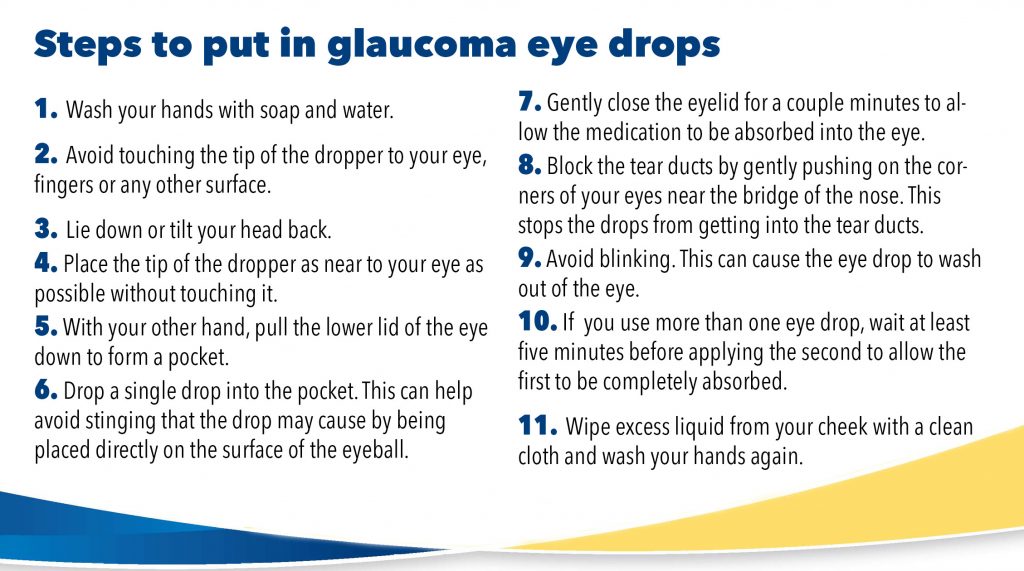The goal of any glaucoma treatment is to prevent vision loss by lowering pressure in the eye caused by excess fluid. This doesn’t necessarily mean surgery. In fact, the majority of people with glaucoma can manage the condition with medication—usually in the form of eye drops.
When we say “excess fluid” in glaucoma patients’ eyes, we’re not talking about extra tear production. Instead, we are referring to the fluid that is produced in the eye and normally drains back into the venous system. When your eye produces too much fluid or the drainage system doesn’t work correctly, fluid builds up and creates pressure in the eye.
There are many types of glaucoma medications. Some cause the eye to make less fluid, while others help fluid drain from the eye. Let’s look at the types of glaucoma medication available, their side effects and how we help patients follow their medication regimen.
Types of glaucoma drugs and their side effects
Most glaucoma medications come in the form of eye drops. There are some glaucoma drugs that you take by mouth, but they’re used far less often. Some more common types of eye drop medications include:
Prostaglandin Analogs
These drugs increase the outflow of fluid in your eye. You might know them by the names Lumigan, Travatan Z and Xalatan.
Prostaglandin analogs are often the first line of treatment that your doctor will recommend. This is because you only need to take these drops once a day and there are few side effects. The main problems patients have with these drugs are red or stinging eyes.
The drugs also can cause the eyelashes to grow and cause light-colored eyes, such as blue or hazel, to get a bit darker. These side effects are far less common and don’t cause most patients to stop taking the drugs. In fact, many women enjoy the longer lashes!
Beta blockers
These are the second most common type of medication prescribed for glaucoma, and they work by reducing the amount of fluid produced in the eye. Examples include timolol and betaxolol.
Side effects of beta blockers include difficulty breathing, a slowed heart rate and lowered blood pressure. For this reason, they can cause problems for people with heart and lung conditions, such as heart rhythm disorders (arrhythmia), asthma and emphysema. Beta blockers are related to blood pressure medications, so we’re also careful about prescribing them to patients on these medications so we don’t lower their blood pressure too much.
Alpha-adrenergic agonists
These drugs both reduce fluid production and increase drainage in the eye. A common type is Alphagan. The most common side effects of alpha-adrenergic agonists are red, itchy eyes. They also can cause an irregular heartbeat, high blood pressure and fatigue.
Carbonic anhydrase inhibitors
These drugs, which are used less often for glaucoma and also come in a pill form, reduce the production of fluid in the eye. Examples of carbonic anhydrase inhibitors include dorzolamide and brinzolamide. Carbonic anhydrase inhibitors can cause a metallic taste in your mouth; tingling in the hands or feet; and burning, red eyes. They also have been associated with kidney stones.
Improving medication compliance for glaucoma patients
As with any medication, glaucoma drugs only work if you take them—and take them correctly. Not doing so risks vision loss. Unfortunately, one of the biggest hurdles we face when it comes to glaucoma medication is compliance, which refers to patients taking their medication as prescribed.
In fact, according to the Glaucoma Research Foundation, up to 25 percent of glaucoma patients don’t take their medication at all. And another big group of them don’t take it properly, which could mean they forget to take some doses, take it at the wrong time, or take too much or too little.
There can be many reasons for this. One is that patients often are motivated to take medications because they see results. Glaucoma often has no symptoms, so it can be tempting to stop taking your medication or become lax in taking it exactly as prescribed.
Related reading: 5 tips to improve medication compliance
We try to help patients with compliance by finding the simplest, yet effective, medication regimen possible. For example, if you take two eye drops a day, we may be able to find a combination medication that combines two drops in one bottle, so you only have to take one drop a day.
Your doctor should spend time teaching you how to use your medications correctly. This includes making sure you know what time of day to take them, how much to take and how to put drops into your eye.

Reducing side effects of glaucoma drugs also is important to improve compliance. No one wants to take a medication that causes pain or discomfort. Most eye drops will cause an uncomfortable burning or stinging, but this should only last a few seconds. If you experience side effects due to your glaucoma medication, contact your doctor. They may be able to change the medication or dosage over the phone, or they might advise you to stop taking the medication until you can come in for an appointment.
We don’t currently have a cure for glaucoma. While medication usually is the first line of defense against glaucoma, there may come a point at which you’ll need more than drugs to prevent vision-threatening damage. This could include laser procedures such as selective laser trabeculoplasty (SLT), minimally invasive glaucoma surgeries (MIGS) , more traditional surgery, or a combination of medication and surgery. But medication often can delay or in some cases prevent the need for advanced treatment.
Request an appointment with one of our ophthalmologists to discuss your treatment options for glaucoma.
Request an Appointment

